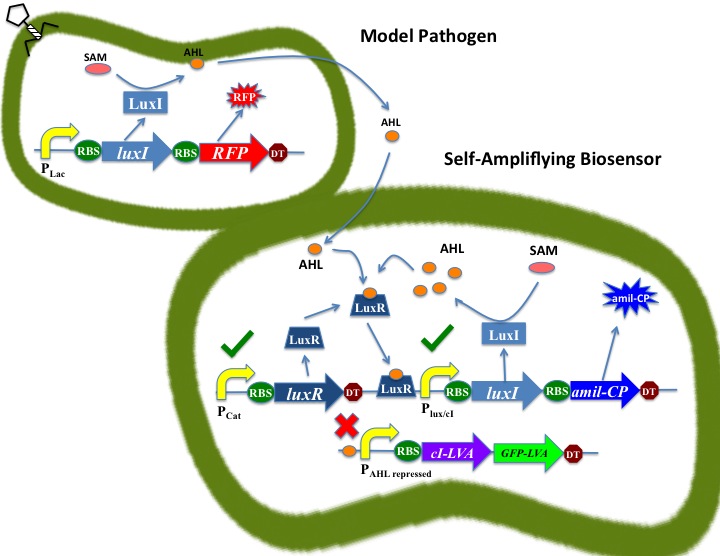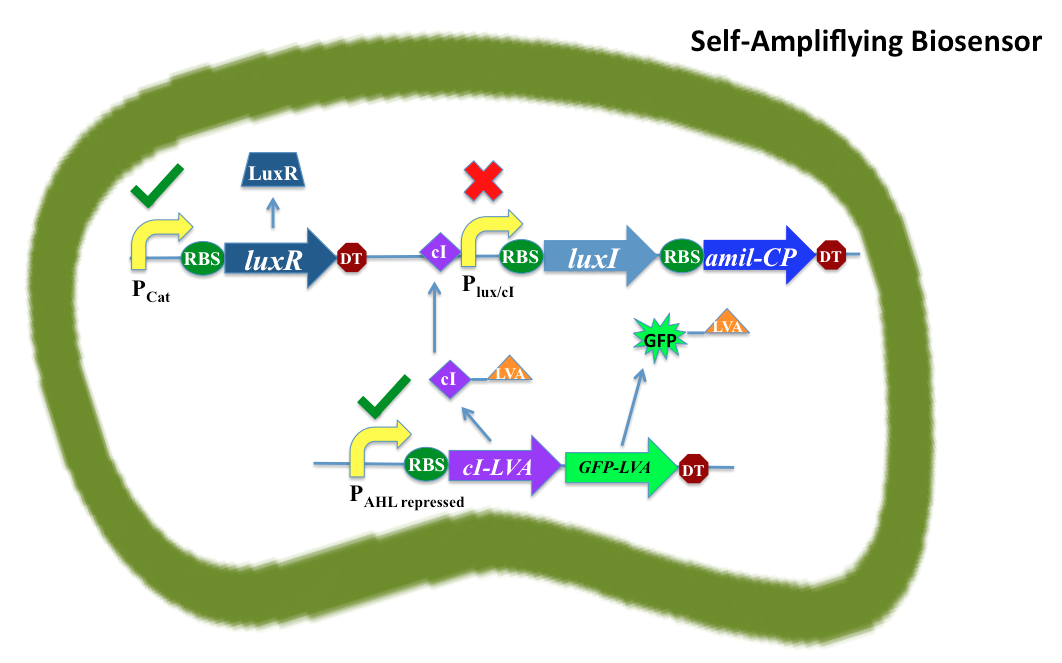Team:Clemson/Project
From 2014.igem.org
Background
Detection of a molecule or signal has been limited in the past by that molecule’s concentration. Here, we propose a system to produce and amplify a desired signal, specifically N-(β-Ketocaproyl)-L-homoserine lactone (AHL). We created a self-amplifying AHL biosensor to assess the potential production of a rapid, cost-effective, and specific signal detection system. Our construct consists of a luxR gene that is constitutively produced by the Pcat promoter. Once bound to AHL, the LuxR activates the Plux promoter, which initiates the transcription of the luxI gene, producing AHL synthase that in turn converts S-adinosylmethionine (SAM) to AHL. The synthesized AHL serves to maintain transcription of the construct while also serving as an AHL source for the activation of other biosensors. In addition to luxI, Plux also regulates the transcription of the downstream reporter gene: gfp or amilCP. Although gfp is a well-characterized system, amilCP produces a blue colorimetric protein visible to the naked eye. Therefore, a single induced biosensor produces AHLs triggering responses from more AHL biosensors in addition to producing measurable reporter signals. In this way, the detection of AHLs in the sample becomes dependent upon the concentration of biosensors in the sample rather than the concentration of AHL produced by the initial signaling cell. The self-amplification of the system was shown to be highly prolific, but a lack of Plux stringency caused immediate activation of the amplification system due to basal luxI transcription and thus AHL self-production. However, in both gfp and amilCP constructs, the amount of reporter translation (measured by relative fluorescence and the naked eye) indicate superior reporting capacity through biosensor self-amplification as compared to the non-self amplified counterparts and both responded to exogenous AHL in a concentration-dependent manner.
How It Works
When no AHL is present, the cI repressor will be produced and bind to the PLux/cI promoter, thus keeping the amplification circuit from activating. GFP will also be produced, confirming that the repressor is binding to the circuit. When the model pathogen is present it will produce AHL, as well as RFP. The AHL will bind to and repress the PAHL repressed promoter, thus stopping transcription of the cI repressor. Any repressor already in the cell will be quickly degraded because of its LVA tag. This degradation is signified by the concurrent degradation of GFP, since it also carries the LVA tag. Once the repressor is inactive, the Plux/cI promoter is free to be activated. Meanwhile, LuxR is being constitutively produced. When AHL binds to LuxR, the AHL-LuzR complex can bind to the PLux/cI promoter, thus activating the amplification circuit. More AHL will be produced by the circuit, thus continuing to encourage transcription of the same circuit in a positive feedback loop. This circuit also produces amil-CP, a blue colormetric protein that serves as a reporter gene. Amil-CP can be viewed with the naked eye and signals the presence of AHL.
System On
System Off
 "
"





